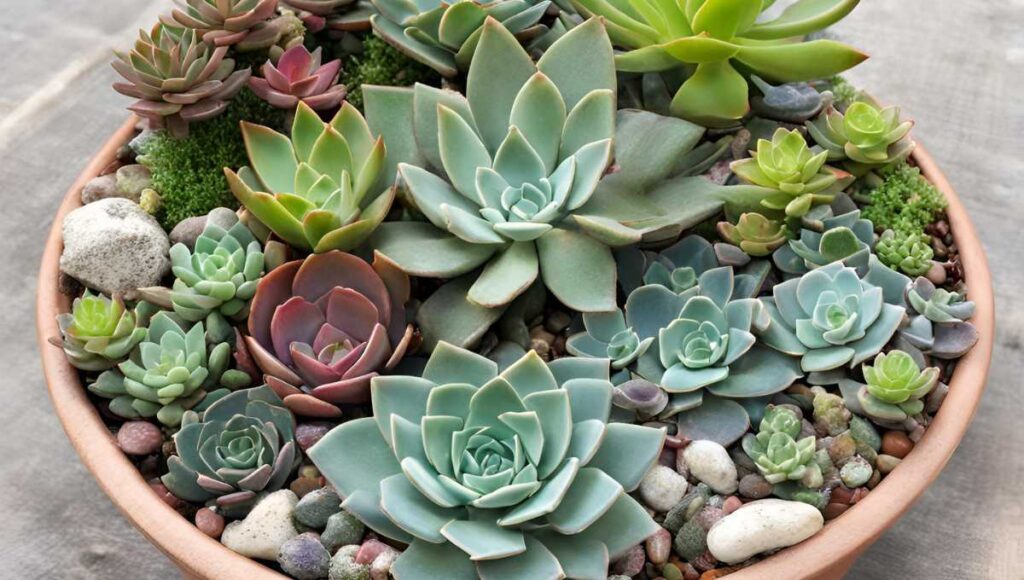
Introduction
In this blog, I want to give 10 tips for planting and taking care of succulent gardens .and this information is going to be geared a little bit more toward beginners. I know there are many ways to do things and lots of great tips out there, but today I’m sharing what helped me the most, especially when I was starting out.
In This Post
Togglehere are 10 tips for planting and caring for succulents:
First, pick a pot that has holes at the bottom for water to drain out succulent gardens.
- Basically anything with a hole in the bottom.
- That way, water has a chance to escape and not pool, which can cause your plant to rot.
The second tip is to use soil in succulent gardens.
- use a soil specifically blended for cacti and succulents because they prefer a soil that’s lighter, faster draining, and has more aeration.
- I do not recommend that you use regular potting soil because it’s too heavy and holds too much moisture.
The third tip is to select a succulent that looks healthy.
- You want to start with something that’s really healthy to begin with.
- Choose one with a nice shape and good color.
- Pick one free of insects and without dead or soggy foliage.
The fourth tip is to plant in succulent gardens:
- To do that, add a bit of cactus or succulent soil at the bottom of your container and work some up around the sides.
- Gently remove the plant from its nursery container and place it on top of the soil.
- After that, put more soil around the root ball and gently press it down to pack the roots well.
- Remember to leave some space between the soil surface and the pot’s rim to prevent water spillage when watering.
Tip number five is to water:
- and you want to water it until just a little bit comes out of the bottom of the pot.
- But you don’t want extra water to gather in the saucer.
- If you have any extra, be sure to pour it out.
- The rule of thumb is to allow the soil to dry between waterings, and depending on your climate and the time of year, this can be once a week to every few weeks.
- If the leaves begin to pucker,.
- then the leaves become translucent and soggy, it’s a sign that your plant needs water.
- it could mean the soil is too moist.
- Make it a habit to check your succulents often to see if they need water.
Tip number six is light.
- Make sure your succulents get four to six hours of morning sunlight during summer.
- but shield them from intense afternoon heat to avoid sunburn.
- In winter, when days are shorter and light is weaker, consider adding extra light if necessary..
Tip number seven is to fertilize in succulent gardens.
- Succulents, like all plants, need food.
- How often you fertilize depends on the variety of succulents you have.
- so it’s best to research your specific plants.
- Generally, fertilize about once a month with a succulent-specific food.
- Stick to the directions on the fertilizer bottle.
- For example, you might mix one dose with a quart of water.
- Don’t overwater; instead, integrate fertilizing into your regular watering routine.
Tip 8 is to watch out for insects.
- If you see anything starting, you’re going to want to take care of it immediately.
- Maybe take a picture or a sample down to your local garden center so they can help you identify what you’re dealing with and how to take care of it.
- Most succulents don’t handle insecticides well.
- so I wouldn’t recommend using them.
- The most common insects I come across are mealybugs, which are small and look fuzzy.
- When I spot them on my plants, I use a q-tip dipped in isopropyl alcohol to carefully wipe them away.
Tip 9 is to groom your plants.
- Insects and diseases thrive on dead and decaying foliage.
- so keeping your plants clear of that will promote their happiness and health.
- And they look a whole lot nicer.
- And as a side note, there are several succulents that produce a really fine powder on their foliage, even though it’s not detrimental to their health.
- Try to refrain from touching that foliage.
- because they look a whole lot better when they’re not marred with a bunch of fingerprints.
The final tip is to monitor the temperature.
- Most succulents can’t tolerate very cold temperatures.
- If you live in a cold climate, like I do.
- Remember to bring them indoors before the first frost arrives.
FAQ
Succulents should be watered sparingly, allowing the soil to dry out completely between waterings. Frequency may vary depending on factors such as climate, season, and the type of succulent.
Yes, many succulent species can thrive indoors, provided they receive adequate sunlight and proper care. Choose well-draining soil and containers with drainage holes to prevent waterlogged root.
Common pests that may affect succulents include aphids, mealybugs, spider mites, and scale insects. Regular inspection and prompt treatment can help prevent infestations.
- While succulents can survive in nutrient-poor soils, occasional fertilization can promote growth and enhance coloration. Use a balanced fertilizer formulated for succulents and apply sparingly during the growing season.
Succulents can be propagated through various methods, including leaf cuttings, stem cuttings, and offsets. Follow proper techniques and provide suitable growing conditions for successful propagation.






